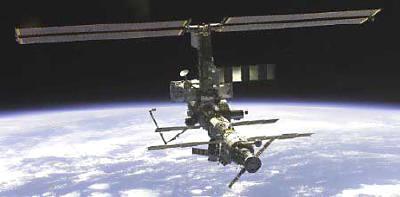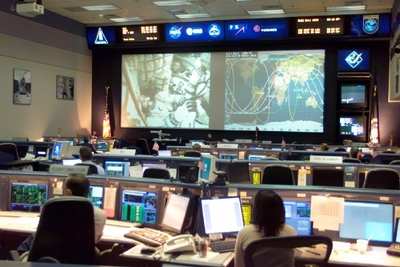ISS Crew Still Trying To Determine Loss In Air Pressure
 As Expedition 8 Commander Mike Foale
celebrated his 47th birthday on aboard the International Space
Station Wednesday and Flight Engineer Alexander Kaleri observed the
Russian Orthodox Christmas, they both concentrated on
troubleshooting a small decay in the Station cabin’s
atmospheric pressure.
As Expedition 8 Commander Mike Foale
celebrated his 47th birthday on aboard the International Space
Station Wednesday and Flight Engineer Alexander Kaleri observed the
Russian Orthodox Christmas, they both concentrated on
troubleshooting a small decay in the Station cabin’s
atmospheric pressure.
The pressure decay poses no threat to the crew's safety or to
the continued operation of the Station and its systems, but Russian
and US engineers are conducting a thorough investigation of the
decrease, which appears to have begun about Dec. 22. The decline
occurs at a rate so small, only a few hundredths of a pound per
square inch (psi) of pressure per day, that it is difficult to
detect.
This week, Foale and Kaleri checked a variety of valves and
seals throughout the Station using an ultrasonic leak detection
system and found no leaks. Today, Kaleri checked a Russian system,
called Vozdukh, that removes carbon dioxide from the cabin as well
as several other Russian systems for leaks and found none.

To continue the effort to diagnose the source of the pressure
decay, flight controllers in Russia and the US plan to ask the crew
to shut off portions of the Station periodically in coming days. In
the next few days, hatches will be closed for periods ranging
between 12-24 hours to seal off various modules to check if any
element within them could be the source of a leak. Those modules
may include the Progress cargo vehicle, the Pirs Docking
Compartment and Soyuz spacecraft, and the Quest airlock.
If those steps do not detect the source of the leak, then the
crew may be asked to move into the Russian living quarters module
for several days and shut hatches separating the Russian living
quarters and other modules from the rest of the station for several
days. Those actions would likely not take place any earlier than
Wednesday. Engineers are continuing to work on potential plans for
those steps to diagnose the leak and to review the number of
hatches that would be closed at that time.

The decay in pressure over the past few weeks aboard the station
has amounted to a decrease from the normal pressure of 14.7 psi, a
pressure equivalent to sea level on Earth, to a pressure today of
about 14 psi, a pressure equivalent to the normal air pressure in
Oklahoma City. The changes in pressure do not present a concern for
the health of the crew. Also, plentiful supplies of air, oxygen and
nitrogen, are aboard the station -- enough that the current rate of
decay could be sustained for six months without further supplies
aboard if required. However, engineers are confident they will
identify and correct the source of the decay as they continue the
diagnostic work onboard.
Flight controllers may feed more nitrogen into the Station
atmosphere late Sunday or Monday to increase the overall air
pressure and maintain the cabin atmosphere in the optimal range for
the operation of equipment aboard the complex. Russian flight
controllers also are continuing to evaluate the possible
replacement of parts of the Station's oxygen-generating Elektron
system. The Russian system generates oxygen by recycling wastewater
aboard the complex. It has failed, but spare parts are aboard that
engineers are confident can bring it back to full operation and
they are developing plans to perform that work possibly next week.
While the Elektron failure is being evaluated, the crew has used
Solid Fuel Oxygen Generators, canisters that are heated to produce
oxygen, to replenish oxygen on the Station.

Despite the leak detection activities, engineers are not certain
the fluctuation and slight decline in pressure aboard the Station
is the result of a leak from the complex. Evaluations continue to
determine if it instead could result from or be significantly
contributed to by troubleshooting and intermittent Elektron
operation, SFOG oxygen generation activities, recent changes in
temperature and sun angles, the accuracy of various pressure
measuring systems, or other factors.
 ANN's Daily Aero-Linx (04.13.24)
ANN's Daily Aero-Linx (04.13.24) ANN's Daily Aero-Term (04.13.24): Beyond Visual Line Of Sight (BVLOS)
ANN's Daily Aero-Term (04.13.24): Beyond Visual Line Of Sight (BVLOS) Airborne 04.09.24: SnF24!, Piper-DeltaHawk!, Fisher Update, Junkers
Airborne 04.09.24: SnF24!, Piper-DeltaHawk!, Fisher Update, Junkers Aero-News: Quote of the Day (04.14.24)
Aero-News: Quote of the Day (04.14.24) ANN's Daily Aero-Term (04.14.24): Maximum Authorized Altitude
ANN's Daily Aero-Term (04.14.24): Maximum Authorized Altitude






